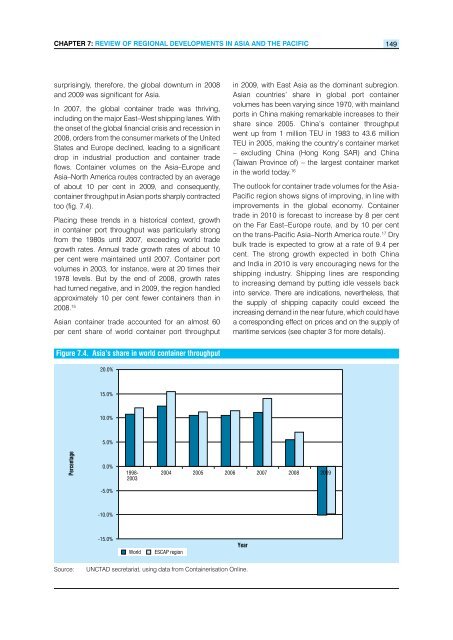Review of Maritime Transport 2010 - Unctad
Review of Maritime Transport 2010 - Unctad
Review of Maritime Transport 2010 - Unctad
Create successful ePaper yourself
Turn your PDF publications into a flip-book with our unique Google optimized e-Paper software.
CHapteR 7: <strong>Review</strong> <strong>of</strong> ReGionaL DeveLopMents in asia anD tHe paCifiC 149<br />
surprisingly, therefore, the global downturn in 2008<br />
and 2009 was significant for Asia.<br />
In 2007, the global container trade was thriving,<br />
including on the major East–West shipping lanes. With<br />
the onset <strong>of</strong> the global financial crisis and recession in<br />
2008, orders from the consumer markets <strong>of</strong> the United<br />
States and Europe declined, leading to a significant<br />
drop in industrial production and container trade<br />
flows. Container volumes on the Asia–Europe and<br />
Asia–North America routes contracted by an average<br />
<strong>of</strong> about 10 per cent in 2009, and consequently,<br />
container throughput in Asian ports sharply contracted<br />
too (fig. 7.4).<br />
Placing these trends in a historical context, growth<br />
in container port throughput was particularly strong<br />
from the 1980s until 2007, exceeding world trade<br />
growth rates. Annual trade growth rates <strong>of</strong> about 10<br />
per cent were maintained until 2007. Container port<br />
volumes in 2003, for instance, were at 20 times their<br />
1978 levels. But by the end <strong>of</strong> 2008, growth rates<br />
had turned negative, and in 2009, the region handled<br />
approximately 10 per cent fewer containers than in<br />
2008. 15<br />
Asian container trade accounted for an almost 60<br />
per cent share <strong>of</strong> world container port throughput<br />
Figure 7.4. Asia’s share in world container throughput<br />
Percentage<br />
20.0%<br />
15.0%<br />
10.0%<br />
5.0%<br />
0.0%<br />
-5.0%<br />
-10.0%<br />
-15.0%<br />
1998-<br />
2003<br />
World ESCAP region<br />
Source: UNCTAD secretariat, using data from Containerisation Online.<br />
in 2009, with East Asia as the dominant subregion.<br />
Asian countries’ share in global port container<br />
volumes has been varying since 1970, with mainland<br />
ports in China making remarkable increases to their<br />
share since 2005. China’s container throughput<br />
went up from 1 million TEU in 1983 to 43.6 million<br />
TEU in 2005, making the country’s container market<br />
– excluding China (Hong Kong SAR) and China<br />
(Taiwan Province <strong>of</strong>) – the largest container market<br />
in the world today. 16<br />
The outlook for container trade volumes for the Asia-<br />
Pacific region shows signs <strong>of</strong> improving, in line with<br />
improvements in the global economy. Container<br />
trade in <strong>2010</strong> is forecast to increase by 8 per cent<br />
on the Far East–Europe route, and by 10 per cent<br />
on the trans-Pacific Asia–North America route. 17 Dry<br />
bulk trade is expected to grow at a rate <strong>of</strong> 9.4 per<br />
cent. The strong growth expected in both China<br />
and India in <strong>2010</strong> is very encouraging news for the<br />
shipping industry. Shipping lines are responding<br />
to increasing demand by putting idle vessels back<br />
into service. There are indications, nevertheless, that<br />
the supply <strong>of</strong> shipping capacity could exceed the<br />
increasing demand in the near future, which could have<br />
a corresponding effect on prices and on the supply <strong>of</strong><br />
maritime services (see chapter 3 for more details).<br />
2004 2005 2006 2007 2008 2009<br />
Year

















